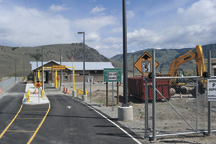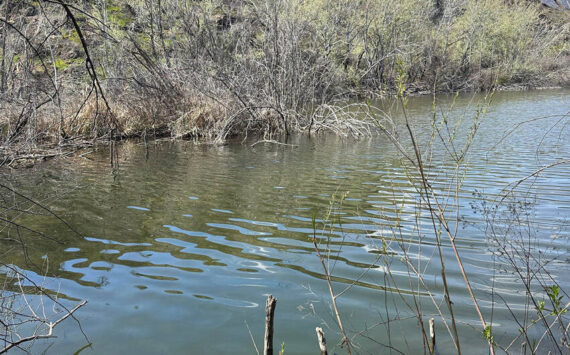
When approaching the new Nighthawk U.S. Port of Entry from Canada travelers first must pass through a Radiation Portal Monitor and then proceed to the primary booth. Photo by Gary DeVon
NIGHTHAWK – The new $6 million U.S. Port of Entry at Nighthawk opened with little fanfare last week, but the high-tech port has many features that will help enhance border security while better serving travelers, according to U.S. Customs and Border Protection.
The new facility replaces the outdated customs building and was funded as part of the American Recovery and Reinvestment Act of 2009. Like the old facility, operational hours at the U.S. Port and Canada’s nearby Chopaka Port of Entry remain 9 a.m. to 5 p.m. daily.
“This new port facility will enhance our mission to secure our borders,” said Oroville Service Port Director, Ron Arrigoni. “The new technologies deployed here, along with the enhanced facility and infrastructure, will provide more efficient, secure and expedited processing for travelers crossing our northern border.”
The new Nighthawk facility features cutting-edge inspection technologies that both strengthen security and expedite inspections. These facilities support current inspection requirements and will be adaptable for CBP’s future border security and trade facilitation needs.
On pulling up to the new facility travelers attempting to enter the country will probably first see the two 100-foot wind-powered generators. There are also three 20’x40′ state-of-the-art solar arrays situated nearby that tilt and rotate to follow the sun. These arrays can also lie flat and automatically lower themselves to the ground if the wind were to blow 50 miles per hour or more. In addition, the 100-foot wind generator towers are articulated so they can be hydraulically leaned over for repairs to the generator without having to climb to the top. The heating and cooling for the facility is through a high-efficiency ground-loop geothermal infrastructure buried beneath the area where the solar panels are placed, according to the Port Director.
“Last week our total power bill was about $2.50,” said Arrigoni, who predicts that number will drop to zero when the solar panels take full advantage of the summer sunshine.
“All our lighting now uses LED bulbs which use 40 percent less power,” he added.
In fact, between the solar panels, wind-generators and energy efficiency upgrades, the port will actually produce excess power that Okanogan County PUD will buy from the federal government as part of voter-approved state requirements for electric utilities to purchase a certain percentage of renewable energy.
“We used to get our power from the Canadian side, but they do not have the ability to buy back power, so the PUD laid in a new line and we can take advantage of their buy-back program,” Arrigoni said, adding that CenturyLink also installed several new lines to the facility to increase communications and network reliability.
The next thing the visitor will see when coming up to the port is the lane that goes between the main building and the booth. First you have to cross through the new yellow RPM, Radiation Portal Monitor. The old port had an RPM as well, but this is an updated one.
“The RPM does not produce radiation, but it detects it. It is so sensitive it can detect an old compass,” Arrigoni said.
After stopping for the RPM and getting the green light to proceed from the CBP officer, vehicles move up to the inspection area between the main building and the primary booth (which the old port did not have). If necessary, two large garage doors on each side can be dropped during the inspection, according to Arrigoni. There is also a cage where animals can be placed if need be during the inspection to both protect the animal and the officer, he said.
Travelers may be asked to come inside and if so they are buzzed in to a small waiting area, with seating that’s bolted to the floor and a window to speak with the inspector. There’s a bathroom also, but visitors must also be buzzed through to that so they can’t just run in and try and flush contraband down the toilet, according to Arrigoni.
In the main building there is a large desk for the officers with several computer monitors for information and communication as well as monitors that show views from video cameras located in several areas around the crossing.
“We have big windows so we can see everything that is going on… it gives us a lot better view of the border area,” Arrigoni said, adding that the facility has enviable views of Mt. Chopaka as well.
“This building and the booth are both constructed using bullet proof walls and windows.”
Down a corridor are several doors behind which are an interview room, processing area (which the old port did not have) and a separate search area.
“The old port had a holding room, but no bathroom which this one does. Then we have a secure storage room for evidence, etc., a general storage room and a safe and secure computer network room. On the other side of the corridor Arrigoni points to an area that will be used as a workout room, but as yet is not equipped. There’s also a small kitchenette for the officer’s use.”
The holding room is designed to hold someone until they can be transported to the main Port of Entry at Oroville, according to Arrigoni.
“There are still a few minor construction details that need to be completed, but overall it is a very well-designed facility that fits our needs. Our technological requirements have really been increased since we became part of the CBP nine years ago,” said Arrigoni, who is in charge of eight border ports from Nighthawk to Medaline Falls.
CBP is using Recovery Act funds to modernize more than 35 land ports of entry along the northern border to meet security and operational needs. The new facility in Nighthawk supports current inspection requirements and will be adaptable for CBP’s future border security and trade facilitation needs, according to a recent CBP press release.
The Department of Homeland Security (DHS) continues to invest additional personnel and technology along the northern border-deploying more than 2,200 Border Patrol agents and nearly 3,800 CBP officers throughout the region to manage the flow of people and goods through ports of entry and designated border crossings.
CBP continues to deploy state-of-the-art technology along the northern border, including thermal camera systems, Mobile Surveillance Systems, and Remote Video Surveillance Systems. Additionally, CBP unmanned aircraft currently patrol nearly 950 miles along the Northern border from Washington to Minnesota, and approximately 200 miles along the northern border in New York and Lake Ontario.





